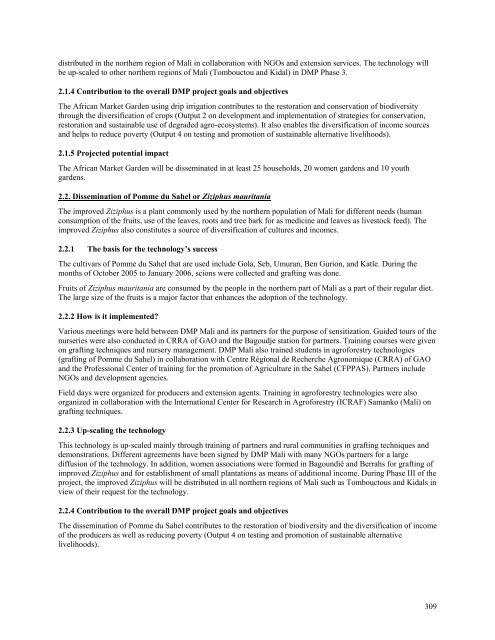ICRISAT Archival Report 2006 - The seedlings of success in the ...
ICRISAT Archival Report 2006 - The seedlings of success in the ...
ICRISAT Archival Report 2006 - The seedlings of success in the ...
You also want an ePaper? Increase the reach of your titles
YUMPU automatically turns print PDFs into web optimized ePapers that Google loves.
distributed <strong>in</strong> <strong>the</strong> nor<strong>the</strong>rn region <strong>of</strong> Mali <strong>in</strong> collaboration with NGOs and extension services. <strong>The</strong> technology will<br />
be up-scaled to o<strong>the</strong>r nor<strong>the</strong>rn regions <strong>of</strong> Mali (Tombouctou and Kidal) <strong>in</strong> DMP Phase 3.<br />
2.1.4 Contribution to <strong>the</strong> overall DMP project goals and objectives<br />
<strong>The</strong> African Market Garden us<strong>in</strong>g drip irrigation contributes to <strong>the</strong> restoration and conservation <strong>of</strong> biodiversity<br />
through <strong>the</strong> diversification <strong>of</strong> crops (Output 2 on development and implementation <strong>of</strong> strategies for conservation,<br />
restoration and susta<strong>in</strong>able use <strong>of</strong> degraded agro-ecosystems). It also enables <strong>the</strong> diversification <strong>of</strong> <strong>in</strong>come sources<br />
and helps to reduce poverty (Output 4 on test<strong>in</strong>g and promotion <strong>of</strong> susta<strong>in</strong>able alternative livelihoods).<br />
2.1.5 Projected potential impact<br />
<strong>The</strong> African Market Garden will be dissem<strong>in</strong>ated <strong>in</strong> at least 25 households, 20 women gardens and 10 youth<br />
gardens.<br />
2.2. Dissem<strong>in</strong>ation <strong>of</strong> Pomme du Sahel or Ziziphus mauritania<br />
<strong>The</strong> improved Ziziphus is a plant commonly used by <strong>the</strong> nor<strong>the</strong>rn population <strong>of</strong> Mali for different needs (human<br />
consumption <strong>of</strong> <strong>the</strong> fruits, use <strong>of</strong> <strong>the</strong> leaves, roots and tree bark for as medic<strong>in</strong>e and leaves as livestock feed). <strong>The</strong><br />
improved Ziziphus also constitutes a source <strong>of</strong> diversification <strong>of</strong> cultures and <strong>in</strong>comes.<br />
2.2.1 <strong>The</strong> basis for <strong>the</strong> technology’s <strong>success</strong><br />
<strong>The</strong> cultivars <strong>of</strong> Pomme du Sahel that are used <strong>in</strong>clude Gola, Seb, Umuran, Ben Gurion, and Katle. Dur<strong>in</strong>g <strong>the</strong><br />
months <strong>of</strong> October 2005 to January <strong>2006</strong>, scions were collected and graft<strong>in</strong>g was done.<br />
Fruits <strong>of</strong> Ziziphus mauritania are consumed by <strong>the</strong> people <strong>in</strong> <strong>the</strong> nor<strong>the</strong>rn part <strong>of</strong> Mali as a part <strong>of</strong> <strong>the</strong>ir regular diet.<br />
<strong>The</strong> large size <strong>of</strong> <strong>the</strong> fruits is a major factor that enhances <strong>the</strong> adoption <strong>of</strong> <strong>the</strong> technology.<br />
2.2.2 How is it implemented?<br />
Various meet<strong>in</strong>gs were held between DMP Mali and its partners for <strong>the</strong> purpose <strong>of</strong> sensitization. Guided tours <strong>of</strong> <strong>the</strong><br />
nurseries were also conducted <strong>in</strong> CRRA <strong>of</strong> GAO and <strong>the</strong> Bagoudje station for partners. Tra<strong>in</strong><strong>in</strong>g courses were given<br />
on graft<strong>in</strong>g techniques and nursery management. DMP Mali also tra<strong>in</strong>ed students <strong>in</strong> agr<strong>of</strong>orestry technologies<br />
(graft<strong>in</strong>g <strong>of</strong> Pomme du Sahel) <strong>in</strong> collaboration with Centre Régional de Recherche Agronomique (CRRA) <strong>of</strong> GAO<br />
and <strong>the</strong> Pr<strong>of</strong>essional Center <strong>of</strong> tra<strong>in</strong><strong>in</strong>g for <strong>the</strong> promotion <strong>of</strong> Agriculture <strong>in</strong> <strong>the</strong> Sahel (CFPPAS). Partners <strong>in</strong>clude<br />
NGOs and development agencies.<br />
Field days were organized for producers and extension agents. Tra<strong>in</strong><strong>in</strong>g <strong>in</strong> agr<strong>of</strong>orestry technologies were also<br />
organized <strong>in</strong> collaboration with <strong>the</strong> International Center for Research <strong>in</strong> Agr<strong>of</strong>orestry (ICRAF) Samanko (Mali) on<br />
graft<strong>in</strong>g techniques.<br />
2.2.3 Up-scal<strong>in</strong>g <strong>the</strong> technology<br />
This technology is up-scaled ma<strong>in</strong>ly through tra<strong>in</strong><strong>in</strong>g <strong>of</strong> partners and rural communities <strong>in</strong> graft<strong>in</strong>g techniques and<br />
demonstrations. Different agreements have been signed by DMP Mali with many NGOs partners for a large<br />
diffusion <strong>of</strong> <strong>the</strong> technology. In addition, women associations were formed <strong>in</strong> Bagoundié and Berrahs for graft<strong>in</strong>g <strong>of</strong><br />
improved Ziziphus and for establishment <strong>of</strong> small plantations as means <strong>of</strong> additional <strong>in</strong>come. Dur<strong>in</strong>g Phase III <strong>of</strong> <strong>the</strong><br />
project, <strong>the</strong> improved Ziziphus will be distributed <strong>in</strong> all nor<strong>the</strong>rn regions <strong>of</strong> Mali such as Tombouctous and Kidals <strong>in</strong><br />
view <strong>of</strong> <strong>the</strong>ir request for <strong>the</strong> technology.<br />
2.2.4 Contribution to <strong>the</strong> overall DMP project goals and objectives<br />
<strong>The</strong> dissem<strong>in</strong>ation <strong>of</strong> Pomme du Sahel contributes to <strong>the</strong> restoration <strong>of</strong> biodiversity and <strong>the</strong> diversification <strong>of</strong> <strong>in</strong>come<br />
<strong>of</strong> <strong>the</strong> producers as well as reduc<strong>in</strong>g poverty (Output 4 on test<strong>in</strong>g and promotion <strong>of</strong> susta<strong>in</strong>able alternative<br />
livelihoods).<br />
309

















